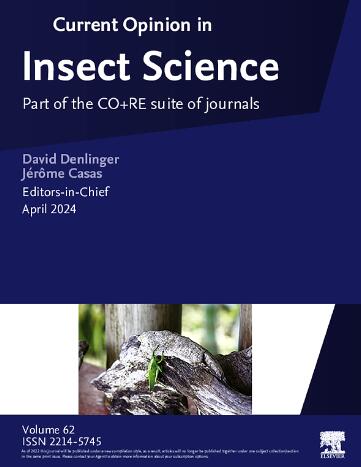Microbial, genetic, and urban drivers of ant invasions
IF 4.8
1区 农林科学
Q1 BIOLOGY
引用次数: 0
Abstract
Invasive ants are among the most destructive invaders worldwide, causing ecological disruption, economic losses, and public health risks. While classic traits such as polygyny, colony budding, and supercoloniality are well-known contributors to their success, emerging research reveals a broader suite of mechanisms driving their invasiveness. This review synthesizes recent findings on the microbial, genetic, and behavioral factors that facilitate ant invasions. Microbial interactions play a crucial role; invasive ants often exhibit a loss of natural enemies, including microbial pathogens such as Wolbachia. However, Wolbachia has received growing attention for its potential mutualistic role in enhancing colony productivity and nutrient provisioning. The bridgehead effect, wherein invasive populations establish strategic hubs that facilitate secondary invasions, has been increasingly recognized as a key driver of global ant spread and may promote genetic intermixing among invasive lineages. Genetic mechanisms such as double clonality, sexually antagonistic selection, and tolerance to inbreeding help invasive ants maintain genetic diversity despite founding populations often consisting of relatively few individuals. Additionally, urban environments impose unique selective pressures that may lead to adaptations favoring success across all stages of the invasion process. This framework aligns with the Anthropogenically Induced Adaptation to Invade (AIAI) hypothesis and helps explain why many urban-adapted ants become globally invasive. As urbanization continues to expand, human-modified landscapes may inadvertently serve as breeding grounds for future invasive species. Understanding these multifaceted invasion dynamics provides critical insights for managing invasive ant populations and mitigating their widespread impacts.
蚂蚁入侵的微生物、基因和城市驱动因素。
入侵蚂蚁是世界上最具破坏性的入侵者之一,造成生态破坏、经济损失和公共卫生风险。虽然一夫多妻制、群体萌芽和超级殖民等经典特征是众所周知的成功因素,但新兴研究揭示了推动它们入侵的更广泛的机制。本文综述了促进蚂蚁入侵的微生物、遗传和行为因素方面的最新发现。微生物相互作用起着至关重要的作用;入侵蚂蚁经常表现出天敌的丧失,包括微生物病原体,如沃尔巴克氏体。然而,沃尔巴克氏体因其在提高菌落生产力和营养供给方面的潜在互惠作用而受到越来越多的关注。桥头堡效应,即入侵种群建立促进二次入侵的战略枢纽,已被越来越多地认为是全球蚂蚁传播的关键驱动因素,并可能促进入侵谱系之间的遗传混合。遗传机制,如双克隆、性对抗选择和对近亲繁殖的耐受,帮助入侵蚂蚁保持遗传多样性,尽管建立的种群通常由相对较少的个体组成。此外,城市环境施加了独特的选择压力,这可能导致在入侵过程的所有阶段都有利于成功的适应。这一框架与人类诱导的入侵适应(AIAI)假说一致,并有助于解释为什么许多适应城市的蚂蚁变得具有全球入侵性。随着城市化的不断扩大,人类改造的景观可能无意中成为未来入侵物种的繁殖地。了解这些多方面的入侵动态为管理入侵蚂蚁种群和减轻其广泛影响提供了关键的见解。
本文章由计算机程序翻译,如有差异,请以英文原文为准。
求助全文
约1分钟内获得全文
求助全文
来源期刊

Current opinion in insect science
BIOLOGYECOLOGYENTOMOLOGY-ECOLOGY
CiteScore
10.40
自引率
1.90%
发文量
113
期刊介绍:
Current Opinion in Insect Science is a new systematic review journal that aims to provide specialists with a unique and educational platform to keep up–to–date with the expanding volume of information published in the field of Insect Science. As this is such a broad discipline, we have determined themed sections each of which is reviewed once a year.
The following 11 areas are covered by Current Opinion in Insect Science.
-Ecology
-Insect genomics
-Global Change Biology
-Molecular Physiology (Including Immunity)
-Pests and Resistance
-Parasites, Parasitoids and Biological Control
-Behavioural Ecology
-Development and Regulation
-Social Insects
-Neuroscience
-Vectors and Medical and Veterinary Entomology
There is also a section that changes every year to reflect hot topics in the field.
Section Editors, who are major authorities in their area, are appointed by the Editors of the journal. They divide their section into a number of topics, ensuring that the field is comprehensively covered and that all issues of current importance are emphasized. Section Editors commission articles from leading scientists on each topic that they have selected and the commissioned authors write short review articles in which they present recent developments in their subject, emphasizing the aspects that, in their opinion, are most important. In addition, they provide short annotations to the papers that they consider to be most interesting from all those published in their topic over the previous year.
 求助内容:
求助内容: 应助结果提醒方式:
应助结果提醒方式:


